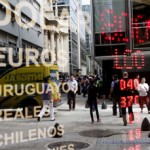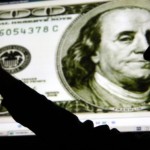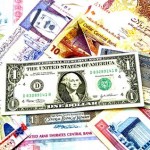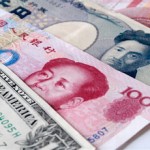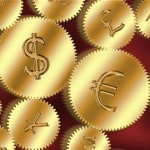Dollar Snaps 3-Day Skid on Gains in Retail Sales; Krone Declines
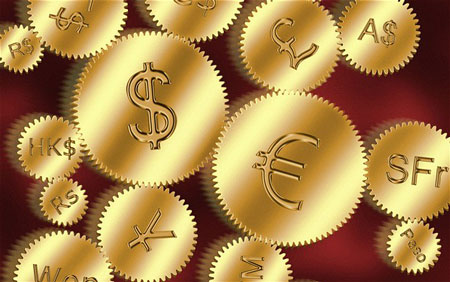
The dollar snapped a three-day skid after U.S. retail sales climbed the most in eight months, further evidence of a strengthening economy as the Federal Reserve considers its first interest-rate increase since 2006.
The greenback gained versus most major peers as the number of Americans filing for jobless benefits dipped to a three-week low before the central bank meets Dec. 16-17. The yen fell for the first time in four days as Prime Minister Shinzo Abe’s Liberal Democratic Party was poised for re-election this weekend. Norway’s krone slipped below 9 per euro for the first time since 2009 on an unexpected interest-rate cut. The Mexican peso plunged as emerging-market currencies fell.
“As long as U.S. data continues to be much stronger than data in the rest of the world, the dollar will continue to strengthen,” said Kate Warne, a St Louis-based investment strategist at Edward Jones & Co., which manages $870 billion. The retail-sales report “really does bode well for another quarter of strong growth.”
The Bloomberg Dollar Spot Index, which tracks the U.S. currency against 10 major peers, rose 0.6 percent to 1,118.18 at 5 p.m. New York time, after falling to 1,108.21, the lowest since Dec. 2.
The yen weakened 0.7 percent to 118.65 per dollar after surging 3 percent the previous three days. Japan’s currency depreciated 0.4 percent to 147.27 per euro. The dollar rose 0.3 percent to $1.2411 per euro.
Ruble Tumbles
A gauge of global foreign-exchange volatility jumped to a 15-month high. JPMorgan Chase & Co.’s volatility index rose to 9.61 percent, the highest since September 2013, up from this year’s low of 5.28 percent in July.
The ruble weakened even after Russia’s central bank increased its key interest-rate by 100 basis points to 10.5 percent. While the move matched the median estimate a Bloomberg survey, investors are speculating it won’t be enough to stem the currency’s 41 percent decline this year.
The ruble lost as much as 3.4 percent to 56.70 per dollar before trading at 56.44.
A gauge of developing-economy currencies slid to the lowest level in more than a decade amid speculation that the Fed will begin raising interest rates sooner than forecast. The measure fell 0.5 percent to 82.2952, the least since April 2003.
Peso, Krone
Mexico’s peso slumped 1.5 percent to 14.7772 against the dollar even after the central bank sold $200 million to support the currency. That’s the biggest tumble after the ruble among 24 emerging-market currencies tracked by Bloomberg. The Philippine peso added 0.5 percent, one of just two gainers.
Norway’s krone weakened after the central bank lowered its deposit rate to 1.25 percent from 1.5 percent and as the price of oil fell below $60 a barrel for the first time since July 2009. The krone depreciated 1.5 percent to 9.0475 per euro and touched 9.0732, the weakest since July 2009.
The yen dropped after Kyodo News reported yesterday Abe’s party may win more than 300 of 475 lower house seats in the Dec. 14 election. The LDP’s coalition partner Komeito may take more than the 31 seats it currently holds, the agency said, citing a telephone survey.
Japan’s currency has tumbled more than 30 percent in the past two years as Abe implemented his economic policy of monetary easing, fiscal spending and structural reform.
“He’ll come back in, which means continuation of Abenomics and very loose policy,” said Peter Kinsella, a senior currency strategist at Commerzbank AG in London. “There’s no reason to buy the yen on a medium-term horizon.”
‘Rate Normalization’
The dollar advanced as the 0.7 percent gain in retail purchases matched the highest estimate of economists surveyed by Bloomberg and followed a 0.5 percent advance in October that was larger than previously reported, Commerce Department figures showed in Washington.
Jobless claims decreased by 3,000 to 294,000 in the week ended Dec. 6. The median forecast in a Bloomberg survey of economists called for first-time applications to hold at 297,000. Claims have been below 300,000 for 12 of the past 13 weeks.
The U.S. currency has rallied for the past five months amid speculation an improving economy will spur the Fed to raise interest rates. Policy makers will increase the benchmark from the current range of zero to 0.25 percent in about eight months, data compiled by Morgan Stanley show.
Fed Chair Janet Yellen “is going to lay the groundwork” for the first increase, said Quincy Krosby, a market strategist based in Newark, New Jersey, at Prudential Financial Inc., which oversees $1 trillion in assets. “As long as data continue to show wage gains and broad improvement in the jobs market, they want to begin rate normalization ever so slowly and patiently.”
Source: Bloomberg – Dollar Snaps 3-Day Skid on Gains in Retail Sales; Krone Declines









